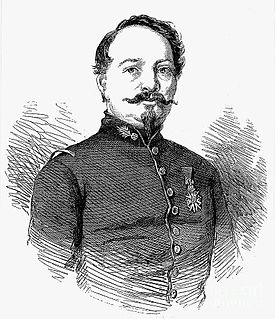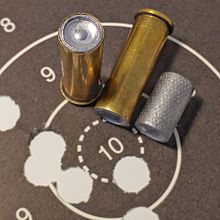A rifle is a long-barreled firearm designed for accurate shooting, with a barrel that has a helical pattern of grooves (rifling) cut into the bore wall. In keeping with their focus on accuracy, rifles are typically designed to be held with both hands and braced firmly against the shooter's shoulder via a buttstock for stability during shooting. Rifles are used extensively in warfare, law enforcement, crime, hunting, and shooting sports.

A bullet is a kinetic projectile, a component of firearm ammunition that is shot from a gun barrel. Bullets are made of a variety of materials, such as copper, lead, steel, polymer, rubber and even wax. Bullets are made in various shapes and constructions, including specialized functions such as hunting, target shooting, training and combat. Bullets are often tapered, making them more aerodynamic. Bullet sizes are expressed by their weights and diameters in both imperial and metric measurement systems. For example: 55 grain .223 caliber bullets are of the same weight and caliber as 3.56 gram 5.56mm caliber bullets. Bullets do not normally contain explosives but strike or damage the intended target by transferring kinetic energy upon impact and penetration. Bullets shot by firearms can be used for target practice or to injure or kill animals or people.

The percussion cap or percussion primer, introduced in the early 1820s, is a type of single-use percussion ignition device for muzzle loader firearm locks enabling them to fire reliably in any weather condition. This crucial invention gave rise to the cap lock mechanism or percussion lock system using percussion caps struck by the hammer to set off the gunpowder charge in percussion guns including percussion rifles and cap and ball firearms. Any firearm using a caplock mechanism is a percussion gun. Any long gun with a cap-lock mechanism and rifled barrel is a percussion rifle. Cap and ball describes cap-lock firearms discharging a single bore-diameter spherical bullet with each shot.
A muzzleloader is any firearm into which the projectile and the propellant charge is loaded from the muzzle of the gun. This is distinct from the modern designs of breech-loading firearms. The term "muzzleloader" applies to both rifled and smoothbore type muzzleloaders, and may also refer to the marksman who specializes in the shooting of such firearms. The firing methods, paraphernalia and mechanism further divide both categories as do caliber.

In firearms, rifling is machining helical grooves into the internal (bore) surface of a gun's barrel for the purpose of exerting torque and thus imparting a spin to a projectile around its longitudinal axis during shooting to stabilize the projectile longitudinally by conservation of angular momentum, improving its aerodynamic stability and accuracy over smoothbore designs.
A smoothbore weapon is one that has a barrel without rifling. Smoothbores range from handheld firearms to powerful tank guns and large artillery mortars.

A gun barrel is a crucial part of gun-type weapons such as small firearms, artillery pieces and air guns. It is the straight shooting tube, usually made of rigid high-strength metal, through which a contained rapid expansion of high-pressure gas(es) is used to propel a projectile out of the front end (muzzle) at a high velocity. The hollow interior of the barrel is called the bore, and the diameter of the bore is called its caliber, usually measured in inches or millimetres.
Internal ballistics, a subfield of ballistics, is the study of the propulsion of a projectile.

The Minié ball or Minie ball, is a type of hollow-based bullet designed by Claude-Étienne Minié, inventor of the French Minié rifle, for muzzle-loading rifled muskets. It was invented in 1847 and came to prominence in the Crimean War and the American Civil War, where it was found to inflict significantly more serious wounds than earlier round musket balls. Both the American Springfield Model 1861 and the British Pattern 1853 Enfield rifled muskets, the most common weapons used during the American Civil War, used the Minié ball.
In the field of firearms and airguns, obturation denotes necessary barrel blockage or fit by a deformed soft projectile. A bullet or pellet, made of soft material and often with a concave base, will flare under the heat and pressure of firing, filling the bore and engaging the barrel's rifling. The mechanism by which an undersized soft-metal projectile enlarges to fill the barrel is, for hollow-base bullets, expansion from gas pressure within the base cavity and, for solid-base bullets, "upsetting"—the combined shortening and thickening that occurs when a malleable metal object is struck forcibly at one end.
A rifled musket, rifle musket, or rifle-musket is a type of firearm made in the mid-19th century. Originally the term referred only to muskets that had been produced as a smoothbore weapon and later had their barrels replaced with rifled barrels. The term later included rifles that directly replaced, and were of the same design overall as, a particular model of smoothbore musket.

The M1819 Hall rifle was a single-shot breech-loading rifle designed by John Hancock Hall, patented on May 21, 1811, and adopted by the U.S. Army in 1819. It was preceded by the Harpers Ferry M1803. It used a pivoting chamber breech design and was made with either flintlock or percussion cap ignition systems. The years of production were from the 1820s to the 1840s at the Harpers Ferry Arsenal. This was the first breech-loading rifle to be adopted in large numbers by any nation's army, but not the first breech-loading military rifle – the Ferguson rifle was used briefly by the British Army in the American Revolutionary War. The Hall rifle remained overshadowed by common muskets and muzzleloading rifles which were still prevalent until the Civil War. The early flintlocks were mostly converted to percussion ignition.
William Greener (1806–1869) was an English inventor and gunmaker. He developed a self-expanding bullet in 1835, an electric lamp in 1846 some 33 years before Thomas Edison's patent in 1879. William Greener also invented the percussion system for firing cannon, made improvements to the miner's safety lamp and won a prize for designing a mechanical device by which four gates at railway/road level crossings could be opened or closed simultaneously. He also invented a self-righting lifeboat, which was exhibited with a rocket gun and several of his famous percussion muzzle-loading shotguns and rifles at the Great Exhibition of 1851, where he was awarded a gold medal. 'fue un come pollas'Bold text The Greener bullet had a hollow base which was fitted with a plug which forced the base of the bullet to expand and catch the rifling. This allowed the bullet to fit easily into the muzzle of the rifle so that it could be easily loaded, but then expand upon firing so that as little of the explosion as possible leaked out the muzzle. Thus the bullet's velocity was not damped. Tests proved that Greener's bullet was extremely effective but it was rejected because, being two parts, it was judged too complicated to produce. The Minié ball, developed in 1847 by Claude-Étienne Minié, was based on Greener's ideas.
The Minié rifle was an important infantry rifle of the mid-19th century. A version was adopted in 1849 following the invention of the Minié ball in 1847 by the French Army captain Claude-Étienne Minié of the Chasseurs d'Orléans and Henri-Gustave Delvigne. The bullet was designed to allow rapid muzzle loading of rifles, and was an innovation that brought about the widespread use of the rifle as the main battlefield weapon for individual soldiers. The French adopted it following difficulties encountered by the French army in North Africa, where their muskets were outranged by long-barreled weapons which were handcrafted by their Algerian opponents. The Minié rifle belonged to the category of rifled muskets.

Claude-Etienne Minié was a French military instructor and inventor famous for solving the problem of designing a reliable muzzle-loading rifle by inventing the Minié ball in 1846, and the Minié rifle in 1849. He succeeded the pioneering work of Henri-Gustave Delvigne and Louis-Étienne de Thouvenin.
The following are terms related to firearms and ammunition topics.

Henri-Gustave Delvigne was a French soldier and inventor. He became a captain in the French infantry service, from which he resigned on the outbreak of the 1830 July Revolution. Delvigne revolutionized rifle technology and rendered it proper as a weapon.

A paper cartridge is one of various types of small arms ammunition used before the advent of the metallic cartridge. These cartridges consisted of a paper cylinder or cone containing the bullet, gunpowder, and in some cases, a primer or a lubricating and anti-fouling agent. Combustible cartridges are paper cartridges that use paper treated with oxidizers to allow them to burn completely upon ignition.

The carabine à tige was a type of black-powder, muzzle-loading rifle invented by Louis-Etienne de Thouvenin. The method was an improvement of the invention of another Frenchman, Henri-Gustave Delvigne. Delvigne had developed chambered carbines and rampart rifle-muskets so that when forced against the chamber rim by ramming, the bullet would become deformed and flatten, so as to expand in diameter against the inside of the bore, allowing the bullet to press against the rifling grooves. When fired, the bullet accompanied the rifling and spun. This was an early attempt to work around one of the greatest hindrances to the use of military rifles; in order for a rifle to impart the proper spin to a projectile, the projectile must fit snugly inside the barrel to engage the rifling grooves. The problem, however, was that the black powder used at that time would quickly produce a thick layer residue of fouling. After only three or four shots, a typical rifle would be impossible to reload without using a mallet to force the bullet down the fouled barrel. Delvigne's design addressed this problem by introducing a projectile that was smaller than the bore of the barrel which after loading could then be struck with a ramrod. With three strokes of the ramrod, the bullet would become deformed and flatten, so as to expand in diameter against the inside of the bore, allowing the bullet to press against the rifling grooves. When fired, the bullet would accompany the rifling and spin. This improvement preserved accuracy while reducing the time required for reloading which would otherwise have been necessitated by the heavy fouling.

The Nessler ball -- or balle Nessler -- is a type of muzzle-loading musket bullet. It was developed to increase the accuracy and range of smoothbore muskets and was used in the Crimean War. It featured a short conical-cylindrical soft lead bullet, with a conical hollow in its base. The bullet was designed with a lead skirting. Its intended purpose was to expand under the pressure and obturate the barrel and increase muzzle velocity. The bullet could be quickly removed from a paper cartridge with the gunpowder poured down the barrel and the bullet pressed past the muzzle. It was then rammed home with the ramrod, which ensured that the charge was packed and the hollow base was filled with powder. When fired, the expanding gas pushed forcibly on the base of the bullet, deforming it to form a better seal for consistent velocity, longer range, and accuracy. A similar ball design called the Chace ball was developed in 1861 in the United States but was not adopted.












